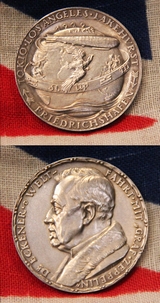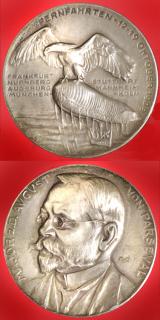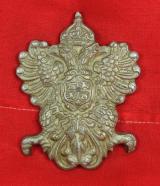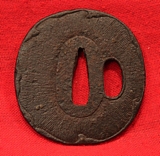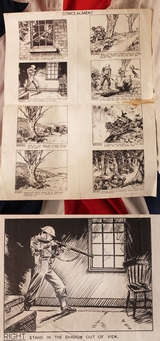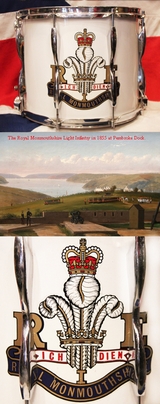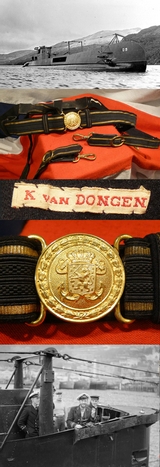A Rare Karl Goetz Silver Zeppelin World Circumnavigation Medal of 1929
A Rare Karl Goetz Zeppelin Medal. Silver medal of 1929, for circumnavigation of the world, in the airship LZ 127. Half-length portrait of the air pioneer and airship leader Hugo Eckener. Aircraft and flying eagle in front of globe, around the globe a band with star signs. With a punch: BAYER. MAIN COIN OFFICE ? FINE SILVER. 59.98 mm; 54.37 g. Matt finish, very pretty patina, small edge error, almost uncirculated read more
425.00 GBP
A Very Rare Long Distance Flight Medal, Major von Parseval 1909
Designed by world renown medalist Karl Goetz [1875 - 1950]
Very Rare silver medal, for the flight of 12th to 19th October, 1909. Long-distance voyages of the Parseval airships. Half-length portrait of the airship designer A. Parseval to the left / eagle stands with outstretched wings on the bow of the airship, below water surface, above right inscription. Hallmark: feinsilber BAYER. MAIN MINT OFFICE. it was awarded in two grades silver and bronze, this, the silver is an incredibly rare antique aviation medal from the earliest days of airships. August von Parseval (5 February 1861, in Frankenthal (Pfalz) – 22 February 1942, in Berlin) was a German airship designer.
As a boy, Von Parseval attended the Royal Bavarian Pagenkorps in Munich from 1873 to 1878, where he took the Fähnrichexamen (cadet exams). He then joined the Royal Bavarian 3rd Infantry Regiment Prinz Carl von Bayern. An autodidact, he busied himself with the problems of aeronautics. In the garrison town of Augsburg he came into contact with August Riedinger and also came to know his later partner Rudolf Hans Bartsch von Sigsfeld, with whom he developed Drachenballons: balloons used by the military for observation.
In 1901 Parseval and Sigsfeld began building a dirigible airship. After Sigsfeld's death during a free balloon landing in 1902, the work was interrupted until 1905.
By 1905, thanks to improvements in motor design, an appropriate engine was now available. His designs were licensed to the British Vickers company. Up to the end of the First World War, 22 Parseval airships (both non-rigid (blimps) and semi-rigid (with keels)) were built. In the late twenties and early thirties, four more semi-rigid airships were built in accordance with the "Parseval-Naatz principle". read more
675.00 GBP
A Large 19th century European, Imperial, Crowned, Twin Headed Royal Eagle Crest Mount
In hard metal, probably solid nickel. A most attractive piece that could beautifully embellish either a fine box, door, cabinet, case, or maybe a bespoke wooden plaque. 225 grams, 3.5 inches x 4.5 inches read more
225.00 GBP
A Unique 'Sealed Pattern' Cap Badge of the Fusilier Brigade 16.9 1966
Inspectorate of Stores and Clothing . Since the early XVIII Century, it was common practice for all European armies to approve items of clothing and accoutrements for each regiment in a formal session of the appropriate War Office `Dress Committee`.
At these sessions, an example of each item would be deposited with the Committee, signed, sealed and certified as being the `Sealed Pattern`, against which all items worn in future would be compared. At future inspections of each regiment, any item showing variations from the norm would be amended or scrapped. since the start of the eighteenth century a band of officers of the British Army (or other responsible persons) has approved the quality and finish of all items of military clothing, it was then sealed with the wax of the Board of Ordnance or other Government seal to be recognised as the standard to be kept by the manufacturers. There is valuable evidence to be seen on these patterns because they also carry the date of approval and obsolescence of each item. Unfortunately, that system has not proved to be infallible. In 1841, all sealed patterns accumulated since the beginning of the eighteenth century, were destroyed in a fire at the Tower of London. No secondary store existed and thus all patterns encompassing Marlborough?s campaigns, the Seven Years War, the American War of Independence and the Napoleonic Wars were lost. read more
195.00 GBP
Iron Round Chisa Katana or Wakazashi Tsuba With Amidayasuri and Wave Rim
Koto period circa 1550 with very finely chisseled designs. Tsuba are usually finely decorated, and are highly desirable collectors' items in their own right. Tsuba were made by whole dynasties of craftsmen whose only craft was making tsuba. They were usually lavishly decorated. In addition to being collectors items, they were often used as heirlooms, passed from one generation to the next. Japanese families with samurai roots sometimes have their family crest (mon) crafted onto a tsuba. Tsuba can be found in a variety of metals and alloys, including iron, steel, brass, copper and shakudo. In a duel, two participants may lock their katana together at the point of the tsuba and push, trying to gain a better position from which to strike the other down. This is known as tsubazeriai pushing tsuba against each other. read more
375.00 GBP
A Superb, Victorian, Scottish Lord Lieutenant's Belt Plate and Silver Bullion, Belt and Sword Straps. Queen Victoria's Personal Representative in Scotland When She Was Not Available
Belt. Silver bullion belt backed with morocco leather, silver scrolling thistle pattern to the silver lace brocade belt. Since 1831 this has been analogous to the uniform worn by a General Staff Officer, but with silver lace in place of the gold worn by Regular General officers. The Lord-Lieutenant is the British monarch's personal representative in each county of the United Kingdom. Historically, the Lord-Lieutenant was responsible for organising the county's militia. Lieutenants were first appointed to a number of English counties by King Henry VIII in the 1540s, when the military functions of the sheriff were handed over to him. He raised and was responsible for the efficiency of the local militia units of the county, and afterwards of the yeomanry, and volunteers. He was commander of these forces, whose officers he appointed. These commissions were originally of temporary duration, and only when the situation required the local militia to be specially supervised and well prepared; often where invasion by Scotland or France might be expected.
Lieutenancies soon became more organised, probably in the reign of his successor King Edward VI, their establishment being approved by the English parliament in 1550. However, it was not until the threat of invasion by the forces of Spain in 1585 that lieutenants were appointed to all counties and counties corporate and became in effect permanent. Although some counties were left without lieutenants during the 1590s, following the defeat of the Spanish Armada, the office continued to exist, and was retained by King James I even after the end of the Anglo-Spanish War.
The office was abolished under the Commonwealth, but was re-established following the Restoration under the City of London Militia Act 1662, which declared that:
The King's most Excellent Majesty, his Heirs and Successors, shall and may from Time to Time, as Occasion shall require, issue forth several Commissions of Lieutenancy to such Persons as his Majesty, his Heirs and Successors, shall think fit to be his Majesty's Lieutenants for the several and respective Counties, Cities and Places of England and Dominion of Wales, and Town of Berwick upon Tweed.
Although not explicitly stated, from that date lieutenants were appointed to "counties at large", with their jurisdiction including the counties corporate within the parent county. For example, lieutenants of Devon in the seventeenth and eighteenth centuries appointed deputy lieutenants to the City of Exeter, and were sometimes described as the "Lieutenant of Devon and Exeter" The origin of this anomaly may have lain in the former palatine status of Pembrokeshire.
The City of London was uniquely given a commission of lieutenancy, and was exempt from the authority of the lieutenant of Middlesex. The Constable of the Tower of London and the Warden of the Cinque Ports were ex-officio lieutenants for the Tower Hamlets and Cinque Ports respectively, which were treated as counties in legislation regarding lieutenancy and militia affairs.
The official title of the office at this time was His or Her Majesty's "Lieutenant for the county of ..", but as almost all office-holders were Peers of the realm, they were referred to as "Lord-Lieutenant". read more
485.00 GBP
A Rare and Original British WW2 'Concealment' Instructional Poster for The Camouflage Officer
Original British Army poster. With four fold creases and a little staining. 19 inches x 24 inches read more
195.00 GBP
ERII Drum of the Royal Monmouthsire Royal Engineers Regiment.
An ERII, post 1954 drum of a Welsh Royal Engineers regiment. The Royal Monmouthshire. Top skin needs replacing. A most attractive piece of British Military History. The Royal Monmouthshire Royal Engineers (Militia) (R MON RE(M)) is the most senior regiment in the British Army Reserve, having given continuous loyal service to the crown since 1539. It is part of the reserve forces, and is the only remaining Militia unit in the British Army. The regiment is also unusual in having the word Royal appear twice in its name. It gained the first "Royal" in 1804 when it was known as the Monmouth and Brecon Militia. The second was acquired in 1877 when the regiment transferred from an infantry unit into a Special Reserve section of the expanding Royal Engineers. The top skin in split and would need replacing if it was required to be used as a drum once more. read more
575.00 GBP
A Super British Military Surgeon's Campaign Set, In Nickel Plated Cylinder
With numerous tools, scissors clamps etc., and cases for needles and blades, for principally bullet and shrapnel extractions. One instrument lacking. Superbly engineered, and a beautiful quality piece. Maker marked by Brown of Leicester. It appears that the case may be designed to be pressure boil sterilized in the field of combat, with a pressure release type system built into the lid. The significance of military medicine for combat strength goes far beyond treatment of battlefield injuries; in every major war fought until the late 19th century disease claimed more soldier casualties than did enemy action. During the American Civil War (1860?65), for example, about twice as many soldiers died of disease as were killed or mortally wounded in combat. The Franco-Prussian War (1870?71) is considered to have been the first conflict in which combat injury exceeded disease, at least in the German coalition army which lost 3.47% of its average headcount to combat and only 1.82% to disease. In new world countries, such as Australia, New Zealand, the United States and Canada, military physicians and surgeons contributed significantly to the development of civilian health care.
Improvements in military medicine have increased the survival rates in successive wars, due to improvements in medical evacuation, battlefield medicine and trauma care. Similar improvements have been seen in the trauma practices during the Iraq war. Some military trauma care practices are disseminated by citizen soldiers who return to civilian practice. One such practice is where major trauma patients are transferred to an operating theater as soon as possible, to stop internal bleeding, increasing the survival rate. Within the United States, the survival rate for gunshot wounds has increased, leading to apparent declines in the gun death rate in states that have stable rates of gunshot hospitalizations read more
725.00 GBP
An Excellent WW2 Free Dutch Navy, Royal Netherland Navy Submarine Captain's Dress Belt 1930's Used in WW2
The service dress belt of a RNN submarine commander of the Royal Netherlands 'Free' Navy of WW2. Commander of a RNN U Boat, the Free Dutch Navy Submarine of WW2 HNLMS O 19 (N 54). Capt. Van Dongen. Luitenant ter zee 1e klasse (Lt.Cdr.) Karel van Dongen, RNN 0 19, 3 Jul 1939 till 31 May 1941. On 10 May 1940, the day the Germans invaded the Netherlands, the entire mobilization was proclaimed in the Dutch colony. Most Dutch warships, including the O 19, were used to protect allied merchant ships and to patrol the Indonesian archipelago.
The submarine performed multiple patrols and missions in the Pacific theater of World War II, sinking multiple Japanese vessels, attacking shipping convoys and laying mines.
On 8 July 1945, O 19 was en route to Subic Bay in the Philippines at a speed of 16 knots (30 km/h; 18 mph) when it struck Ladd Reef in the South China Sea. Unable to pull free of the reef, the crew of O 19 were rescued by USS Cod. To prevent enemy capture, O 19 was scuttled by her crew using explosives, torpedoes and gunfire An example of the of the calibre of WW2 serving officers who were awarded such a highly respected decoration was the heroic Canadian born, Royal Air Force fighter pilot ace RUSSEL, F/O Blair Dalzell, DSO, DFC (C1319) -
Officer, Order of Orange-Nassau with Swords (Netherlands)
Awarded as per London Gazette dated 23 January 1948 and
AFRO 81/48 dated 6 February 1948.
Public Records Office Air 2/9293 has recommendation drafted when he was a Wing Commander: In operational command of No.126 Wing, Royal Air Force, stationed at the aerodrome Volkel from September 1944 until February until April 1945, through his excellent work has greatly contributed to the liberation of the Netherlands. During World War II, the Order of Orange-Nassau was bestowed upon both members of the Netherlands military and members of foreign services who had helped liberate the Netherlands from Nazi Germany occupation, and those who helped liberate the former Dutch colonies in the Pacific. In the modern age, the Orange-Nassau is still the most active military and civil decoration of the Netherlands, and ranks after the Order of the Netherlands Lion. The Order is typically awarded each year on the Queen's official birthday (April 30) The Order is also used to honour foreign princes, ministers, dignitaries and diplomats.
The Dutch Navy at the beginning of the war with Germany in May 1940, consisted of 1 coastal defence ship, 5 cruisers, 9 destroyers, 27 submarines, 4 gun boats, 6 minelayers and other smaller vessels. The Dutch Navy fought in many parts of sea like North Sea, Mediterranean and the Pacific sea where the Dutch navy had to defend the Dutch colonies from the Japanese advance.
Dutch naval forces had a contribution of sinking many enemy vessels, including 2 U-boats and also Japanese and even Italian submarines. But they also suffered many losses during the war, especially their submarine arm. They lost the coastal defence ship Soerabaja, the 3 cruisers De Ruyter, Java and Sumatra, 9 destroyers, 11 submarines and other smaller vessels. According to records the Royal Dutch Navy lost 59 warships during WWII [40%] Awarded to the Commander of a RNN U Boat, the Free Dutch Navy Submarine of WW2 HNMS O 19 (N 54)
Navy The Royal Dutch Navy
Type Submarine
Class O 19
Pennant N 54
Built by Wilton-Feijenoord (Schiedam, Holland)
Ordered
Laid down 15 Jun 1936
Launched 22 Sep 1938
Commissioned 3 Jul 1939
Lost 10 Jul 1945
Loss position 8? 40'N, 111? 40'E. We also havehis service medal group, for sale seperately read more
225.00 GBP


